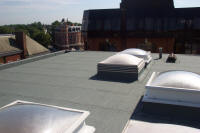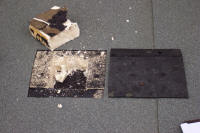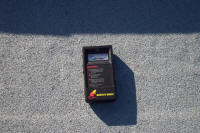| Re-Roofing |
 |
| The design of
re-roofing specifications follows the same principles as new work, but you
have added complications arising from the need to adapt, reuse or overlay
existing materials, or to strip and replace the existing roof specification. |
| First if all, you
will need to do an inspection to determine the limiting factors which will
influence the design and selection of materials. |
| Your
inspection must take into account the condition of the supports, the roof
deck, the insulation and the waterproofing. |
|
If you find the existing insulation is
moisture sensitive, it is likely that the parts near to a source of
leakage are wet or degraded and you will need to replace them. Treading
the area concerned may reveal soft patches which will require attention.
Otherwise take moisture readings, or make test cuts near the source of
the leakage, or at random over the roof. |
 |
 |
|
Electronic, infra-red and other proprietary
methods are also available to survey large roof areas. They give an
indication of water content by temperature variations or by radiation
methods. This work must be carried out by trained specialists who will
submit a detailed report on the possibility of water in the insulation. |
| When
considering the design of the specification, you must understand the reason
for the failure of the original. If old age is the reason, the re-roofing
will be straightforward, as there will be little to change. If the roof has
suffered premature failure, the re-roofing specification must take account
of the factors involved.
|
| Having
established the condition of the existing roofing specification, you can
then consider a number of alternative approaches to roof renewal: |
|
A Single layer torch-on waterproofing applied over existing waterproofing |
| The
single layer torch-on system fully bonds a new thick surface layer onto the
existing waterproofing. The old waterproofing will act as a backing to the
new and provide a measure of lap security. Make sure the old roof covering
is basically sound, rot free, not saturated with water, and the insulation
or deck below is in a generally dry condition. |
|
A new waterproofing system applied over
the existing waterproofing |
| You
may re-roof old waterproof coverings with the direct application of the full
range of built-up roofing materials, but you must ensure the existing
insulation is sound and effective, and the surface of the existing
waterproofing is firm, clean, and sound. You must remove chippings and
blisters to leave a satisfactory surface. |
|
New insulation and waterproofing applied over the existing waterproofing. |
| You
can re-roof old roofs with confidence using an overlay of new insulation,
even if the old roof has suffered major movement or fatigue failure. The
only criteria is that the existing insulation must be in sound condition. |
| There
is usually enough room for a thin layer of insulation to be added, but check
the height of skirtings, position of dampcourse, height of kerbs and
thresholds to make sure that the thickness of the new insulation does not
rob the skirtings of essential height. If the existing roof has poor falls
and drainage with ponded areas, consider introducing tapered insulation or
crickets so that the new roof can be well drained. |
|
You will need to completely strip and relay the
existing insulation if |
- it is saturated or degraded
- it is necessary to inspect the roof deck
- the structure will not support the
weight of an overlay in addition to the original materials
- the height of upstands limits the depth
of extra covering, or
- the attachment of existing materials is
faulty
|
| The
need for you to strip and replace the structure of a roof will arise only
because of the severe deterioration or inadequacy of the roof deck. The
design of the insulation and waterproofing specification is as for a new
roof. |
|
Specifications |
| Use a
fully bonded specification on all insulation boards other than rigid
urethane and phenolic. Fully bonded specifications normally comprise two
layers of high performance material, bonded in hot bitumen. |
| Use a
partially bonded specification on rigid urethane and phenolic insulations or
direct to concrete, cement screeds, plywood and particleboard. Part bonded
specifications normally comprise three layers of material. The first layer
BS 747 type 3G, or similar vented base layer, followed by two layers of high
performance material. |
|
Materials |
|
Polyester felts were originally made with
oxidised bitumen coatings, but the majority are now made with modified
bitumen coatings. The addition of a polymer to the bitumen improves its
properties as a roofing material in almost all respects, and in particular
the flexibility, strength and fatigue resistance. |
| The
most commonly used modifying additives are SBS (styrene butadiene styrene)
and APP (atactic polypropylene). |
|
Overall I would say that Flat Roofing, properly designed will last well in
excess of 20 years and give you exceptionally good service.
|